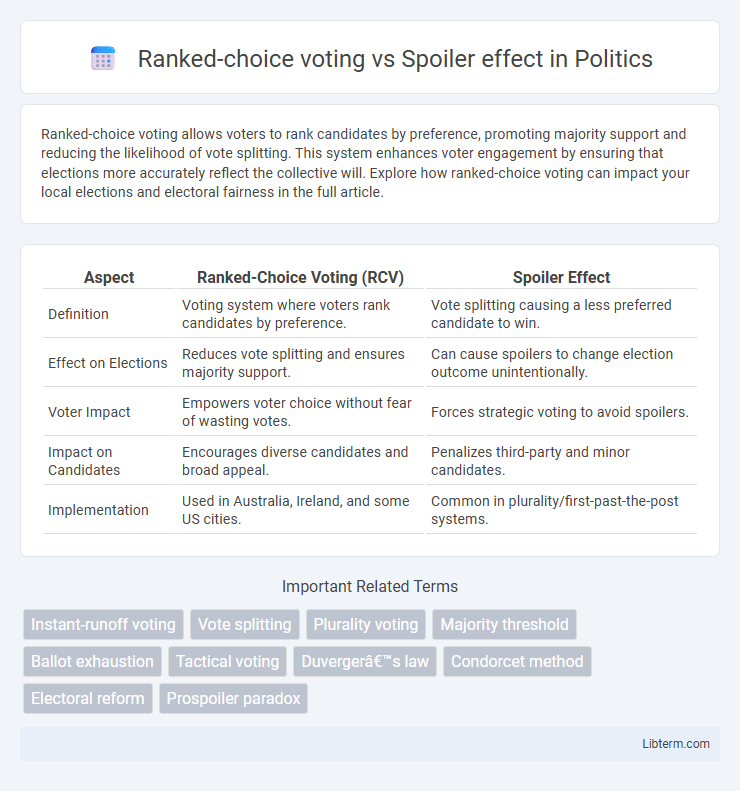Ranked-choice voting allows voters to rank candidates by preference, promoting majority support and reducing the likelihood of vote splitting. This system enhances voter engagement by ensuring that elections more accurately reflect the collective will. Explore how ranked-choice voting can impact your local elections and electoral fairness in the full article.
Table of Comparison
| Aspect | Ranked-Choice Voting (RCV) | Spoiler Effect |
|---|---|---|
| Definition | Voting system where voters rank candidates by preference. | Vote splitting causing a less preferred candidate to win. |
| Effect on Elections | Reduces vote splitting and ensures majority support. | Can cause spoilers to change election outcome unintentionally. |
| Voter Impact | Empowers voter choice without fear of wasting votes. | Forces strategic voting to avoid spoilers. |
| Impact on Candidates | Encourages diverse candidates and broad appeal. | Penalizes third-party and minor candidates. |
| Implementation | Used in Australia, Ireland, and some US cities. | Common in plurality/first-past-the-post systems. |
Introduction to Ranked-Choice Voting
Ranked-choice voting allows voters to rank candidates in order of preference, which reduces the spoiler effect by ensuring that votes for less popular candidates are not wasted. This system reallocates votes from eliminated candidates to voters' next choices until one candidate achieves a majority, promoting majority support and more representative outcomes. Unlike traditional plurality voting, ranked-choice voting minimizes the chances of vote splitting and encourages broader candidate appeal.
Understanding the Spoiler Effect
Ranked-choice voting minimizes the Spoiler Effect by allowing voters to rank candidates by preference, ensuring that votes for less popular candidates are not wasted but reallocated. This system prevents vote splitting that often causes spoilers to inadvertently help elect less favored candidates. Understanding the Spoiler Effect highlights the importance of electoral reforms like ranked-choice voting to produce more representative outcomes.
How Ranked-Choice Voting Works
Ranked-choice voting allows voters to rank candidates in order of preference, which helps mitigate the spoiler effect by ensuring that votes for less popular candidates are not wasted. When no candidate wins a majority initially, the candidate with the fewest votes is eliminated, and their votes are redistributed to the voters' next preferences until a candidate achieves a majority. This system promotes majority support and reduces the likelihood of vote splitting that can lead to spoiler outcomes.
The Mechanics of the Spoiler Effect
The spoiler effect occurs when a third-party or less popular candidate splits the vote, causing a more preferred candidate to lose due to divided support among similar candidates. Ranked-choice voting mitigates this by allowing voters to rank candidates in order of preference, ensuring that votes for less popular candidates are reallocated to the next preferred option. This process reduces vote splitting and ensures the winner has majority support, preserving election integrity.
Ranked-Choice Voting vs Traditional Plurality
Ranked-choice voting (RCV) reduces the spoiler effect by allowing voters to rank candidates in order of preference, ensuring that the winner has majority support rather than just a simple plurality. Unlike traditional plurality voting, where the candidate with the most votes wins even if it is less than 50%, RCV redistributes votes from eliminated candidates to the voters' next choices until one candidate achieves a majority. This system minimizes vote splitting and encourages more diverse candidate participation without penalizing voters for choosing third-party or less popular options.
Can Ranked-Choice Voting Eliminate the Spoiler Effect?
Ranked-choice voting (RCV) significantly reduces the spoiler effect by allowing voters to rank candidates in order of preference, ensuring that votes for less popular candidates are not wasted but transferred to voters' subsequent choices. This system prevents vote splitting among similar candidates, which often causes spoilers in plurality voting. Consequently, RCV promotes majority support and enhances election outcomes by minimizing the impact of spoiler candidates.
Real-World Examples: Ranked-Choice Voting in Action
Ranked-choice voting (RCV) mitigates the spoiler effect by allowing voters to rank candidates in order of preference, preventing vote splitting among similar candidates and ensuring a majority winner. Real-world examples include Maine's 2018 gubernatorial election, where RCV eliminated the need for a runoff by reallocating votes from eliminated candidates, and San Francisco's city elections, which consistently produce winners with broad support despite numerous candidates. These cases demonstrate how RCV enhances electoral fairness and voter representation by reducing the impact of spoilers.
Case Studies: Spoiler Effect Impact on Elections
Ranked-choice voting reduces the spoiler effect by allowing voters to rank candidates in order of preference, preventing vote splitting that can alter election outcomes. Case studies such as the 2009 mayoral race in Burlington, Vermont, demonstrate how ranked-choice voting helped bypass spoilers by redistributing votes from eliminated candidates to preferred ones, ensuring majority support. Similarly, Maine's adoption of ranked-choice voting in 2018 showed a decline in spoiler candidates influencing results, promoting fairer representation.
Benefits and Criticisms of Ranked-Choice Voting
Ranked-choice voting reduces the spoiler effect by allowing voters to rank candidates in order of preference, ensuring that votes for less popular candidates are not wasted but transferred to next choices, promoting majority support. Critics argue that ranked-choice voting can be complex for voters to understand and count, potentially leading to confusion and longer election result times. Proponents highlight increased voter engagement and more diverse candidate representation as significant benefits of this system.
The Future of Election Reform
Ranked-choice voting (RCV) is increasingly recognized as a solution to the spoiler effect by allowing voters to rank candidates in order of preference, reducing vote splitting in multi-candidate races. Election reform advocates argue that RCV promotes majority support winners and enhances democratic representation by ensuring elected officials better reflect voter intentions. Future election reforms are likely to emphasize widespread adoption of RCV to improve electoral fairness and increase voter confidence in outcomes.
Ranked-choice voting Infographic

 libterm.com
libterm.com